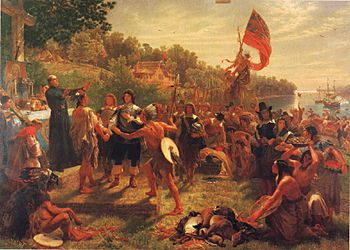Yaocomico facts for kids

The Founding of Maryland (1634) depicts colonists meeting the people of the Yaocomico branch of the Piscataway Indian Nation in St. Mary's City, Maryland, the site of Maryland's first colonial settlement.
|
|
| Total population | |
|---|---|
| Extinct as a tribe | |
| Regions with significant populations | |
| Maryland, north of Potomac River | |
| Languages | |
| Eastern Algonquian, historical | |
| Religion | |
| Native | |
| Related ethnic groups | |
| Piscataway |
The Yaocomico (also spelled Yaocomaco) were a group of Native American people. They spoke an Algonquian language. In the 1600s, they lived near the Potomac River where it meets the Chesapeake Bay. They were related to the Piscataway, who were a powerful group in the area.
When English settlers came to start the Maryland colony, they bought land from the Yaocomico. This land became the first settlement for the colonists. By the end of the 1600s, the Yaocomico tribe was no longer mentioned in history. Experts think this happened because of new diseases brought by Europeans. They also faced challenges from European settlers and other Native groups.
Contents
Who Were the Yaocomico?
The Yaocomico were one of many Algonquian-speaking groups. These groups mostly lived in the coastal areas of what is now Maryland. The Piscataway were the strongest group north of the Potomac River. But there were also many smaller tribes, like the Yaocomico.
Maryland also had Iroquoian-speaking tribes. The Susquehannock lived along the Susquehanna River. They often raided the lands of the Algonquian people. There were also Siouan-speaking tribes to the west and southwest.
Meeting the First Settlers
The first settlers of the Maryland colony bought land from the Yaocomico. This land was for their new settlement at St. Mary's City. The Yaocomico already had a village in this area.
In 1634, Leonard Calvert met the Yaocomico. He was the first governor of the Maryland colony. They met along the Potomac River, near an island the Europeans called St. Clement's Island. Sometimes, "Yaocomico" referred to the people, and sometimes to their leader.
The colonists had traded with other Native groups before. So, they knew a little about how to interact. The Yaocomico traded about 30 acres of land. In return, they received European metal tools and cloth. The Yaocomico seemed ready to move from their village. This spot was perfect for the Europeans because the land was already cleared.
Daily Life and Culture
Father Andrew White, a Jesuit priest, described the Yaocomico in detail. He was one of the early Maryland settlers. They wore deerskin clothes decorated with shells, animal teeth, and feathers. They painted their bodies with different colors. They also drew red and blue lines on their faces.
Yaocomico women had tattoos on their bodies. They used handmade beads to decorate their clothes and themselves. Father White said the Yaocomico were amazing archers. They could throw a stick in the air and hit it with an arrow before it fell. The Yaocomico had a simple government. They usually got along peacefully with other Algonquian groups.
They grew important crops like corn, beans, and squash. These were common foods for woodland Native Americans. They also gathered wild foods, fished, and hunted in the rich coastal environment. The first European settlers wrote about many Native celebrations. These often included big feasts and music. Their musical instruments were made from things found in nature, like rattles, drums, and flutes.
Why They Moved On
European stories say the Yaocomico were willing to sell their land. They were being threatened by Iroquoian-speaking tribes from the north. These included the Susquehannock and the Seneca. The Seneca were part of the Iroquois Confederacy.
Even though they had ties with the Piscataway and the Powhatan Confederacy, the Yaocomico had decided to leave the area. The Susquehannock warriors often raided their villages. These raids had pushed most Algonquian Natives out of the upper Chesapeake Bay. They moved south, where they met the English settlers. The Yaocomico hoped the new settlers would protect them from the Susquehannock.
About half of the Yaocomico left St. Mary's City right away. The other half stayed for a year to harvest their crops. During this time, the Yaocomico helped the settlers a lot. They taught the Europeans how to survive in this new land. In return, the Europeans wrote good things about the Yaocomico. Jesuit priests tried to teach the Natives about Catholicism. They also continued to trade European goods with them.
The Maryland settlers kept good relations with the Yaocomico for many years. They even included rules to protect them in treaties with other tribes. But by the 1670s or 1680s, the Yaocomico disappeared. Historians now believe that diseases from Eurasia were the main reason. Native people had no protection against these diseases, which were common in Europe. There was also ongoing pressure from settlers and other Native groups.
Today, St. Mary's City has a model of the original Yaocomico village. It shows what Algonquian-style longhouses looked like to the first European settlers.

